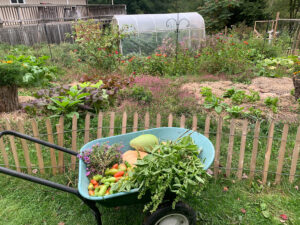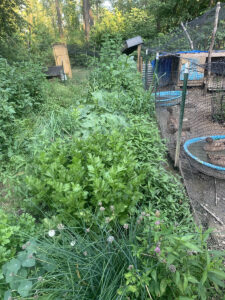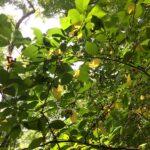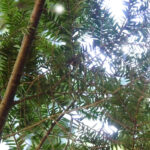I’ve been homesteading (or what those in the UK would call smallholding) since 2010 at two different homesteads. Through this, and through being in community groups and having many friends who are also homesteaders, you learn a lot of things to do and not to do–and not all of these are necessary “beginner” mistakes; rather, you keep making mistakes and learning from them. I get a lot of questions about how to best start out, what to do, and what not to do, so I thought I’d share. I’ll also point to a resource that describes my favorite books about homesteading here.
My homesteads have had moderate acreage–3 acres in Michigan and now 5 acres in Pennsylvania. On our current homestead, we have about 3/4 acre in cultivation (all by hand) and/or in use by our animals. Our current homestead uses permaculture design principles to focus on a mix of annual and perennial agriculture, including food forests, medicinal plants and herbs, hugelkultur, outdoor kitchen and hearth cooking, food preservation, forest regeneration, mushroom cultivation, and bird flocks. Thus, drawing on my 12 years of experience, I’m offering a set of suggestions for things to do–and not do–as a homesteader! The feedback and suggestions I’m offering here are useful to anyone who is starting a garden or homestead of any size.
Planning, Design, and Infrastructure

My first set of suggestions is concerning planning, design, and infrastructure. These are the big picture things that can help set you up for success or cause you a lot of unnecessary work later.
Take the time to observe and interact. While it is really exciting to get started right away, I would suggest taking some really serious time to get to know your land, interact, and observe. In Permaculture Design, the recommendation is a year of observation, and I think this is wise advice. This isn’t to say you can’t do anything during that year–you can do a lot! But I would suggest putting off major decisions for a bit while you learn your land. At a minimum, you want to understand the following: the path of the sun (see solar pathfinder, next) and how shade falls at different times of the year as the sun’s height changes in the sky; where the prevailing winds are in the summer and winter (direction, magnitude); what extreme weather looks like; how warm and cold it gets and when; what kinds of things already grow (this can help you understand microclimates); any sources of pollution; and where the waters flow after rains (where they pool, etc). These are the kinds of information that will help you work with the land and create the best systems you can.
Take time to talk to others in the region. Find some people who are homesteading or doing something similar to what you are planning and make friends. Talk to them about their experience with things like–what grows well (including specific regional varieties), what typical pests they deal with, the other pressures like deer browse, etc. Even if you have experience in one place, moving to a new place creates a whole new set of problems. For example, my first homestead in Michigan had severely alkali soil (P.h. 7.9-8.1), was mostly sand, and the dominant pests were potato beetles and squash borers. Here in Pennsylvania, I’m on very rocky, acidic, clay soil (P.H 5.3-5.5) and the dominant pests are cabbage moths and squash beetles. Those growing conditions really require different kinds of approaches.
Buy a solar pathfinder. The single most useful tool that I have is a solar pathfinder–this is a tool that lets you see the path of the sun, how many hours of light, and how many hours of shade, you have each day. You can purchase a physical one (link above) or you can get an app for your phone. This is an extremely valuable tool for you to understand the kinds of light the site has (and can cut some of your observation time down if you want to start sooner).
Attend to your pollinators in any design. Integrated pest management in your garden begins by making sure that there is support for pollinators, including predatory wasps, and more. Thus, for any gardens, you start to design, make sure you are providing plants with long bloom times. Plants that bloom in June-July are very important as there is usually a midsummer slowdown of nectar (spring blooms are huge with all of the flowering fruit but after that and the clover are out of season, there is little food available). For this, many culinary herbs work well: mint, lavender, oregano, sage, and bee balm are nice choices, as are milkweeds and other mid-season bloomers.
Create a rough master plan. You will want to think not only about what you are doing in years 1-3 but also in years 6-10 and beyond. Even if your master plan is pretty loose, it’s still helpful to have a sense of where you are going and why you are going there. It can help you make better decisions in the short run and not have to relocate or tear things down later. Also keep in mind that you want to plan for growth–what will the tree you are planting in the south of your garden look like in 20 years? Is it being planted in a place that won’t shade out any of your garden beds?
Annual and Perennial Agriculture

Of course, the heart of any homestead is what you are growing. Here are my suggestions for some best practices to consider:
Test your soil and understand your soil fertility. Get a soil test and understand the composition of the soil, what you are deficient in, and consider natural ways to remedy that deficiency. Many of us who homestead or farm recognize that we are not growing plants, we are growing soil! Attending to your soil is one of the very best things that you can do–healthy soil equals stronger and more vigorous plants that are not as subject to diseases or pests. I prefer to use sheet mulching approaches to address soil fertility–I use naturally produced materials (wood ashes, urine, chicken manure composted) and also use cover crops and crop rotation to help build soil. All of these techniques mimic natural processes and build good soil over time. Tilling the soil is very disruptive, so finding ways not to till can really help your soil in the long run. If you live in the US, your local state extension office offers free soil testing kits and information.
Invest in good tools, including a broadfork. If you are looking to avoid using fossil fuels for your garden and not injure yourself in the process, it pays to invest in good tools. A good, sturdy set of tools will be invaluable to you as you begin your homestead. The tools you will want, at minimum, are a good shovel, a hoe, a flat rake, a pitchfork, a garden fork, a wheelbarrow or cart, and a broadfork. The broadfork allows you to aerate the soil very effectively and with minimal effort and while it is a sizable investment. I also love my garden fork, which is great for turning soil, aerating, and loosening the soil for weeding. Pitchfork will be useful as you move mulch, clean animal beds, or move large amounts of weeds. There are other tools you can get, but I consider these my staples.
Plant perennials. Perennial agriculture can help take the work out of your garden. Annuals require the same amount of work each year–you have to start the seeds, tend them carefully, address pests and problems, and prepare the soil for next year’s crops. Thus, as your homestead matures, you want to look for ways to bring as much perennial agriculture into the mix as possible. Perennial food crops often take several years to establish, but once they are established, your only real role is tending them a bit and harvesting. For example, in one of my perennial beds, we have a huge nettle plot that has provided spring greens to us for several weeks while the annual greens in the greenhouse were not yet harvestable (we had a very cold spring). One 8×12 patch of Jerusalem Artichokes produced almost 50 lbs of harvest (not to mention all of the artichokes we put back in the soil) this year, and all I had to do was dig them up and add some new compost each spring. Our currants, raspberries, apples, and more are starting to produce sizable harvests each year. As these crops mature, we will have to rely less on more labor-intensive annual crops. Additionally, the larger variety of perennials you have, the more likely one crop won’t fail and give you a major problem.
Get a greenhouse–but not a prefab one. A greenhouse is necessary if you are interested in having a larger garden (even with an extensive light system setup, at some point, your plants become too numerous and have to go outside in the greenhouse). It is also necessary if you want to extend your harvests beyond the typical season. A 9×18′ greenhouse made out of a carport is what we use quite effectively here at the Druid’s Garden homestead.
Under no circumstances do I recommend purchasing one of those prefab greenhouses. Without fail, every person that I know who purchases one of the prefab greenhouses with the plastic hard panels loses their greenhouse within 1-2 years (at this point, I’ve seen about 20 of these destroyed). Like the prefab chicken coop, they look cute and yet are completely non-functional in actual weather conditions (e.g. 60 mph wind, ice, hail). The greenhouse will fail you and you will lose a lot of work and plants. The only prefab greenhouse that I know is still standing was heavily modified: my friends bolted it down to 4x4s and completely reframed and reinforced it with wood inside. After they did it, they told me they would have been better off just building a greenhouse (and I agree!). I recommend either an actual hoop house or the used carport option. Our carport greenhouse has survived 75 mph winds, ice, hail and so much more–not to mention a used carport is very easy to find and assemble.
Seek out free resources. There are many great–and free–resources that you can find that can help supplement your soil fertility and bring in resources. If your neighbors are having trees cut down, talk with the tree cutters and see if they are willing to drop off the wood chips in your garden (they almost always are). In the fall, go out in your community and gather up the bags of leaves that your neighbors put on the sidewalks–these can be added right to your garden in a sheet mulch or layered in your chicken coop over winter. Around the neighborhood, be in the lookout for what people place on the curb–they often will put tools with broken handles, old pots, plant stands, and any other number of useful things that you can repurpose for your own use!
Source local seed stock. Go to your local farmer’s market and talk to the farmers. See what seed stock they are growing and if they save their seeds. Garlic, for example, often has very local varieties that are well adapted to your climate. Finding those varieties and planting them when possible (for example, the garlic I found was one that a nearby family had been growing for four generations). My garlic is amazing and grows to a massive size each year!
Animal and Bird Flocks
Many people who homestead want their own bird flocks–usually, chickens–and they are a staple of a homestead. I don’t have experience in raising birds for meat; all of our birds are pets who also help generate other things for our homestead (eggs, compost, bug patrol, mowing, etc). I have more details about our flocks and their happiness and needs in this post.

Consider ducks rather than chickens. I think that chickens are a very popular choice, but if I were only to have one bird flock on my homestead, it would be a Khaki Campbell duck. Why? Chickens have many more diseases and issues than ducks have, on average. Heritage ducks out-lay heritage chickens (my ducks lay over 300 eggs each a year). Ducks are more cold-hardy than chickens and can withstand much colder temperatures without issues (chickens, especially roosters, can easily get frostbite on their combs and wattles). Chickens also have very powerful scratching energy that can be quite destructive–if they have access to your garden, they will scratch up your paths, your mulch, and your garden beds. Ducks do not do this (although they will make mud in any pool or water feature you have!). Ducks are smarter than chickens and are very personable and sweet. They are easier to train and stay in a flock better when free-ranging outside. Overall, my recommendation for new homesteaders is to consider ducks over chickens!
Do not purchase a prefab chicken coop. There are a wide range of cute, wooden, compact chicken coops on the market, and you can purchase them from big box stores or online. Every one of these coops has multiple problems that can be very dangerous if not deadly for your flocks. The first is that these coops are not predator-proof–you will have to replace all of the locks on the coop and reinforce the coop to make sure that a fox, weasel, coyote, or raccoon cannot enter (e.g they will need new locks, reinforcement, flooring to prevent digging, and much more). Please remember that your chickens are made of chicken, and everything wants to eat them!
The second big problem with these coops is that they are way too small for a chicken flock (pay no attention to the packaging and what they say). A healthy run includes at least 8-10 square feet per bird; the inside of these coops are super cramped (and if you live in a climate with extreme temperatures, there are days your chickens refuse to come out). Small space indoors and outdoors creates infighting in your flock, which can lead to wounds and infections, not to mention unhappy chickens.
The most successful coops are either those that you build yourself (get help from friends/family if you need it) or that you convert from something like a sturdy garden shed. By using this approach, you will ensure that your coop is large enough for your chickens to be happy and also
Put your birds to work for you. Different kinds of flocks offer different benefits. All of our birds (Geese, Ducks, Guineas, Chickens) lay eggs. Ducks outperform any other laying bird by an order of magnitude. But beyond eggs, you can really capitalize on the natural behaviors of your flocks to keep them happy and help work for the good of the homestead. Here are the ways we work with our birds:
- Geese are natural grass grazers. You can reduce and eliminate the need to mow if you use large pasture paddocks that you move throughout your property. Using grazing animals to keep short clipped lawns was actually where the idea of the lawn originated–so going back to this older form of “lawnmowing” is fully sustainable. Geese are also happy when they are in fresh areas to graze (I will write more about this method in an upcoming post!)
- Chickens have powerful scratching power. Throw leaves, weeds, compost, and grass clippings in your run and allow chickens to turn them into compost. Nitrogen-rich compost will need to sit for at least 6 months to a year before it can be put on the plants. Here’s more on chicken composting!
- Ducks always need fresh water–make their use of water a resource. Situate your duck coop somewhere where the water can drain into your garden–making double use of the water as a resource (and the fresh duck poop, which is high in nitrogen but won’t burn plants).
- Guinea fowl are very powerful tick consumers. By letting your guineas free range during the day, they can help control tick populations.
Conclusion
There is so much to learn and so many things to do on a working homestead! I’m happy to share some of this knowledge and hope it will be useful to you, regardless of the size of the homestead you have or where you are in your process. Blessings to you in your own druid’s garden!



Thank you for compiling such a helpful list!!! I have been homesteading since 1997 in Nova Scotia (currently on Cape Breton Island, which is a zone 5a/b). I only have a couple of things to add to your suggestions – 1) when moving compost, especially manure that is nice and warm and potentially a happy habitat for snakes, do not use a pitchfork, but rather use a digging fork – something where the tines are not capable of skewering a snakes body. I learned this lesson the hard way and will never have forget the moment the lesson happened. 2). Do not put your duck water directly on your garden plants. duck poop/water carries salmonella not to mention e coli and can easily infect your plants. E coli cannot be easily washed off.
So much of what you are talking about I also share with clients and friends and often times I feel that the advice is so simple that its not worth mentioning. But, in fact, much of those simple lessons feel so simple because the knowledge is so deeply imbedded from experience(s)….they are a part of who we are and who we are becoming. I think that the greatest lesson I have learned is to ‘go slow’. I tell people this all the time. Go slow – by using hand tools, as you have described, inherently makes this inevitable. Thanks again.
Thanks for sharing, Ruth! Great additions! I haven’t skewered a snake (I usually move compost with a shovel) but yesterday, I dug up an orange newt that was hanging out in our compost pile (it is cooled off at this point).
Good point about the duck water. We pour it into a swale, which works for us and hits the roots of the plants, not the greenery.
A lot of this stuff does seem really basic and simple–and yet–I see more destroyed greenhouses and lost flocks because people buy poor purchases and expect stuff you buy to work! So I wanted to write this to share that advice because you are right–it is embodied. You figure it out as you go along, and you make a lot of mistakes as you go!
(I’m sitting here writing this with my two baby geese–six days old–tucked in an old sweatshirt. I love the homestead life!)
Great article! I’m always intimidated by growing things (I like to let things go wild), but this makes it seem a little more approachable!
Glad to hear it! Start slow, plant a few things, and see how it goes :). Thanks for commenting and reading!
I’ve been found out a use for Asian Milfoil! It works wonderful for mulch. As it’s high in minerals and replenishes the soil! Thanks, Stephen Gene Pool
Hi Stephen, awesome! When I was in Michigan, people would have their lakes dredged. I was able to get my hands on a big, stinky, steaming pile of seaweed from one of these lakes and you are right–it made amazing and wonderful garden compost!
Homesteaders are learning from each other what people used to learn from parents and grandparents.
Indeed, Joanne! I think we have to re-learn a lot of basic interaction with nature that has been lost. Sometimes it is preserved in certain regions or families, but often, we have to rediscover it. Thank you for your comment and for reading!